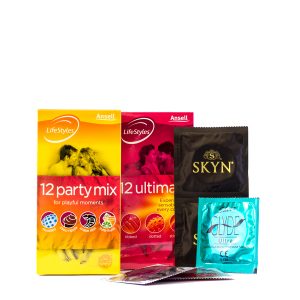What is a condom?
The most common condom is a thin piece of latex (rubber) which is shaped to fit onto an erect (stiff) penis—these condoms can also be called penile or external condoms.
There is also a condom which can be inserted into the vagina or anus—these are called vaginal or internal condoms.
The internal condom is made from polyurethane and can be inserted into the vagina before sex. It is about 15cm long and has two flexible rings, one at each end, to keep it in place in the vagina. One of the rings is enclosed within the condom and this end rests inside the vagina. The other ring, which is open, rests outside.
Non-latex condoms made from polyurethane are also available, but are more expensive.
A condom is used to reduce the risk of sexually transmitted infections (STIs) and pregnancy. Condoms can be used for vaginal, anal or oral sex.

How do condoms work?
Condoms prevent the transfer of genital fluids between sexual partners.
External condoms must be put on before contact occurs between penis and vagina, mouth or anus to be effective, as pre-cum (fluid released when a penis is erect) can contain sperm and transmit infection.
The internal condom should be in place before any genital contact occurs.
Condoms are an effective barrier to prevent infection if they cover the infected area. They won’t protect against STIs if the infection is on an unprotected part of the body and skin-to-skin contact occurs. They can only be used once and then have to be thrown away.
How effective are condoms?
Condoms are effective if used correctly, so it’s good to practise using them before you use them for real.
When used to prevent pregnancy they are between 88-98% effective. Condoms can also be used with other forms of contraception such as the Pill, contraceptive injections, implants and IUDS to reduce the risk of STIs. Condoms are self-lubricated but it’s good to use additional water-based lubricant to prevent the condom breaking.
Where can I get condoms?
Latex and non-latex external condoms are available in supermarkets, pharmacies and some other retail outlets. You can get free condoms from SHINE SA and some other health clinics. Internal condoms are available from the Sex Industry Network shop (200 South Road, Mile End, tel:
8351 7626), or can be purchased from SHINE SA or online retailers.
What are the benefits of using condoms?
- Reduces the risk of pregnancy.
- Reduces the risk of STIs.
- No prescription is needed to buy condoms.
- External condoms are easy to obtain
and are inexpensive.
What are the disadvantages of using condoms?
- Condoms are perishable so they need to be kept in a cool place and used before the expiry date, otherwise they can break.
- Oil based lubricants should not be used such as petroleum jelly or massage oil with latex condoms as these can cause breakage.
- There are no side effects, except if you are allergic to latex rubber or to the lubricant. If either person gets a rash or any discomfort, check with your doctor or clinic.
What are the additional benefits and disadvantages of using internal condoms?
Benefits:
- Unlike the diaphragm, you do not need a fitting or a medical examination before use.
- Can be used to provide STI protection during anal sex (the inner ring should be removed).
Disadvantages:
- Some people find them difficult to insert
and remove. - Not as widely available as the
external condom. - Can make a rustling noise during sex.
- More expensive than the external condom.
Why should lubricant be used with condoms?
Sexual lubricants are water-based substances that reduce friction during sex, which prevents the condom from breaking. It can also make sex more comfortable and pleasurable.
With vaginal intercourse, there may not be enough natural lubrication, this causes more friction and increases the chance that the condom will break. With anal intercourse there’s no natural lubrication so there’s an even greater chance of breakage without lubrication. There’s also less risk of internal small abrasions to your partner if enough lubricant is used.
You can find lubricants where condoms are sold. Only use
water-based products. Other products, like Vaseline, body oils or some vaginal treatments can damage the condoms.
How to use an external condom correctly
- Check the packet by feeling the air bubble to make sure it’s sealed.
- Check the use-by date.
- Pre-cum can transmit infection and sperm, so avoid contact between an erect penis and genitals, anus or mouth before the condom is on.
- Make sure you don’t tear the condom when opening the packet. Don’t unroll it yet, but check to see which way it unrolls.
- Air trapped inside a condom could cause it to break, so squeeze the tip of the condom between your forefinger and thumb and place it over the fully erect penis or sex toy.
- Unroll the rest of the condom down to the base of the penis.
- Apply water-based lubricant to increase pleasure and reduce the risk of the condom breaking.
- If the condom rolls up during sex, roll it back to the base of the penis immediately.
- If the condom comes off or breaks during sex withdraw the penis and put on a new condom before intercourse continues.
- After cumming hold on to the base of the condom and withdraw the penis before it goes soft.
- When removing the condom, don’t allow the condom or penis to touch the genital area. Dispose of the condom carefully.
Sometimes accidents happen
You can contact a doctor, a SHINE SA clinic or the Sexual Healthline to talk about STI checks. If there’s a risk of pregnancy you can take emergency contraception as soon as possible, but up to 5 days after having unprotected sex.






